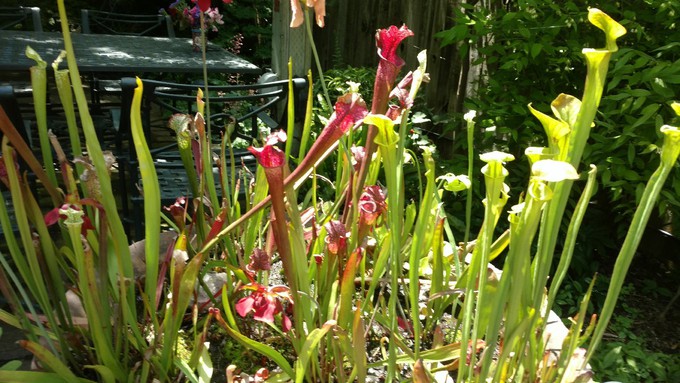
Sacramento Bromeliad and Carnivorous Plant Society hosts 54th annual show and sale at Shepard Center

North American pitcher plants are right at home in an outdoor pond in Sacramento. Debbie Arrington
In most gardens, bugs eat plants. But these plants eat bugs.
Discover the fascinating world of carnivorous plants during the 54th annual Sacramento Bromeliad and Carnivorous Plant Society Show and Sale, set for this Saturday and Sunday, June 15 and 16, at Shepard Garden and Arts Center.
Show and sale hours are 10 a.m. to 4 p.m. Saturday, 10 a.m. to 3 p.m. Sunday. Admission and parking are free.
Club members will be on hand to answer questions and offer advice. An excellent selection of plants will be offered for sale. Find pitcher plants, sundews, butterworts, nepenthes (tropical pitcher plants or “monkey cups”) and other bug eaters as well as tillandsia (air plants) and bromeliads in a rainbow of hues. Don’t miss the Venus flytraps!
This show is fun for all ages. Kids love to experience the bug eaters in action and learn how these plants have evolved to feed themselves. Grown-ups are attracted to the colorful bromeliads, presented as part of a tropical diarama.
See hundreds of intriguing bug-devouring specimens, with several carnivorous species that are right at home in Sacramento. North American pitcher plants, for example, can be grown outdoors in our area. Also known as Sarracenia, they do particularly well as part of a backyard water feature such as a half wine barrel or small pond; their roots get the boggy conditions they prefer while the plants have access to insects that may fly by.
California also has its own native pitcher plant: The cobra lily or California pitcher plant (Darlingtonia californica). A member of the Sarracenia family, the cobra lily is native to sunny wet areas such as stream banks or bogs throughout Northern California. Cobra lilies need cold to thrive, but also require summer heat protection.
“Growing Darlingtonia californica in your own bog garden requires patience and diligence,” says the U.S. Forest Service. “Cool nights are required and as the temperatures warm up in the summer months keeping the roots cool during the day is a must.”
Because they evolved to grow in such poor soil, carnivorous plants get most of their nourishment from insects that can become trapped in their specialized (often sticky) foliage. Likewise, bromeliads trap moisture and nutrients in the center of their swirl of colorful foliage.
Shepard Center is located at 3330 McKinley Blvd., Sacramento, in McKinley Park.
Details and directions: www.sgaac.org.
Comments
0 comments have been posted.Sacramento Digs Gardening to your inbox.
Sites We Like
Garden Checklist for week of July 21
Your garden needs you!
* Keep your vegetable garden watered, mulched and weeded. Water before 8 a.m. to reduce the chance of fungal infection and to conserve moisture.
* Feed vegetable plants bone meal, rock phosphate or other fertilizers high in phosphate to stimulate more blooms and fruiting. (But wait until daily high temperatures drop out of the 100s.)
* Don’t let tomatoes wilt or dry out completely. Give tomatoes a deep watering two to three times a week.
* Harvest vegetables promptly to encourage plants to produce more. Squash especially tends to grow rapidly in hot weather. Keep an eye on zucchini.
* Pinch back chrysanthemums for bushy plants and more flowers in September.
* Remove spent flowers from roses, daylilies and other bloomers as they finish flowering.
* Pinch off blooms from basil so the plant will grow more leaves.
* Cut back lavender after flowering to promote a second bloom.
* It's not too late to add a splash of color. Plant petunias, snapdragons, zinnias and marigolds.
* From seed, plant corn, pumpkins, radishes, winter squash and sunflowers.